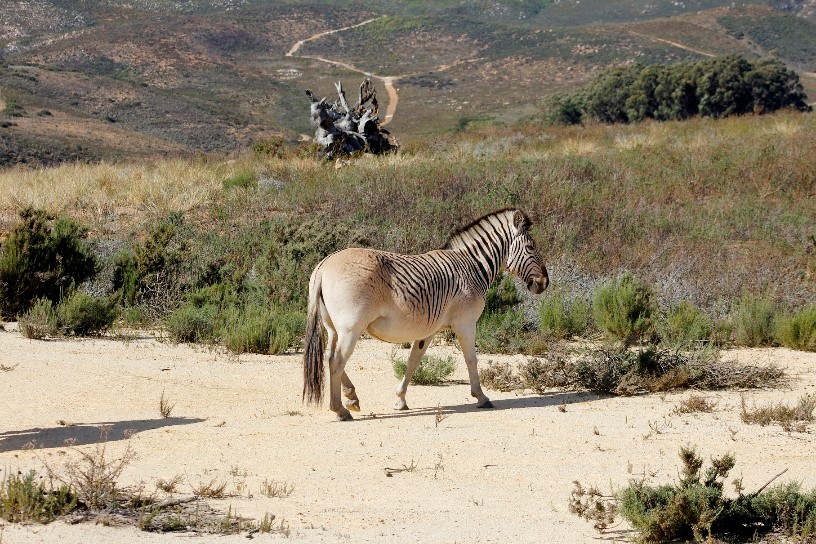Vergelegen wine estate welcomes the Quagga Project
08:25:00Visitors to Vergelegen wine estate might think they’ve tasted a little too much of its delightful wine when they spot a zebra sub-species that was hunted to extinction about 150 years ago.
 |
| Vergelegen wine estate is now home to a group of rare quagga |
Their eyes aren’t deceiving them, however, as this Somerset West estate, which is widely acknowledged for its environmental and sustainability initiatives, is now home to seven ‘Rau’ quagga – one stallion, five mares, and a foal.
The relocation of these rare animals to Vergelegen is the latest milestone in an ambitious project, initiated in 1987, to bring the quagga back from extinction and to introduce them to reserves similar to their former habitat.
Quagga once roamed South Africa in large herds, particularly in the Karoo and southern Free State, until they were hunted out in the second half of the 19th century. The last known mare died in Amsterdam Zoo in 1883.
To mitigate this, a dedicated group of conservationists in the Quagga Project have been selectively breeding from a founder population of southern Plains Zebras in order to retrieve the genes responsible for the animals’ characteristic hide pattern. They describe their breeding animals as Rau quagga, in memory of Reinhold Rau who founded the project.
 |
| A pregnant quagga mare explores her new surroundings |
The seven animals from the Quagga Project were transported from Pampoenvlei in the Atlantis/ Darling area on Tuesday 10 May. They are now settling down in a 180 hectare reserve area which includes natural grazing – a mix of renosterbos, Boland granite fynbos and various grasses – and plentiful water from the farm’s Langkloof Dam.
The quagga share this area with five eland that were introduced to the estate in 2020. The eland form part of the Gantouw Project, which researches how grazing animals can naturally boost ecosystem diversity.
“We first discussed introducing more species to our reserve, in addition to the eland, in early 2021,” said Eben Olderwagen, environmental manager at Vergelegen. “We were put in contact with March Turnbull, director of the Quagga Project, and there was immediate interest from both parties.”
The relocation required considerable planning. Permits were obtained from both CapeNature and the State Veterinary Services, and organisers had to coordinate the availability of the many experts involved, on one day. The weather also played a vital part in proceedings.
.jpg) |
| A resident eland watches the arrival of the quagga |
“Quagga become stressed easily, so relocation has to take place on a day when temperatures are cool and windless, in order to facilitate darting from a helicopter,” said Olderwagen.
“It can also be difficult to book the vet, helicopter pilot and all the other capture professionals on the same day when weather conditions are suitable. Luckily, 10 May was such a day, and the capture and relocation were successful with no damage to or loss of any animals.”
Turnbull explained that quagga differed from other zebras by usually having stripes on the head, neck and front portion of their body only. Their upper sections are brownish rather than white, and the belly and legs are unstriped and whitish.
DNA analysis has revealed that the quagga is not a separate zebra species of its own, but is in fact one of several subspecies or local forms of the southern Plains Zebra (Equus quagga). This fact makes a big difference as selective breeding from a founder population of Plains Zebra has led to a population visually closer to the original quagga population than any other surviving Plains Zebra.
Four of the Vergelegen mares are pregnant and should foal between October and December, added Olderwagen.
“We are absolutely delighted to play a part in this ambitious environmental project,” said Vergelegen MD Wayne Coetzer. “In addition to the historical value of relocating quagga back to this region, the estate offers the space and ecological skills for good biodiversity management and monitoring, with a high likelihood of increasing biodiversity.”
.jpg) |
The Quagga Project is an attempt to use selective breeding to achieve a zebra sub-species which visually resembles the extinct quagga |
Vergelegen is situated in one of the richest floral regions of the world and in 2018 completed a 14-year, privately funded alien vegetation clearing programme. Some 2200 hectares were cleared, of which 1900 hectares have been declared a nature reserve with the same status as the Kruger National Park.
Potential introductions of historically naturally occurring species at Vergelegen could also include black rhino, Cape buffalo, hippo and the geometric tortoise.
The arrival of the quagga offers training opportunities for conservation students in relation to large mammal husbandry, veld management and veld restoration. There is also potential for accredited learnerships or internships as it will be aligned with Vergelegen’s Center of Learning Excellence. Outdoor classroom studies could inspire youngsters to pursue careers in the green economy.
The quagga could in due course be viewed by visitors as part of the estate’s popular ecological game drives. This guided excursion currently takes guests through the Vergelegen arboretum and biodiversity nature reserve, with possible sightings of the estate’s free-range Nguni cattle, bontebok and eland.
Read more:
Vergelegen’s ecological initiatives: https://vergelegen.co.za/nature/
The Quagga Project: https://www.quaggaproject.org/
Vergelegen Environmental Tour
The environmental tour is weather permitting, costs R350 pp and departs from the tasting room at Vergelegen at 10h00. Duration is approximately 1.5 hours.
Contact 021 847 2122 for bookings.
Issued by: MEROPA COMMUNICATIONS
Pictures: SUPPLIED













0 comments